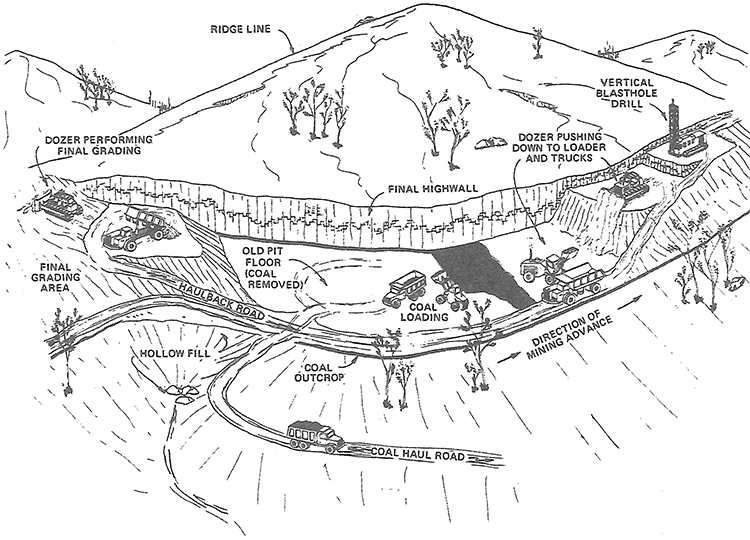3.2.4: Step 2 -- How Much of the Resource is a Reserve?
We started this lesson by noting that reserve estimation is completed in two steps. The first is to estimate the size of the resource, which we have now done. The second step is to determine how much of the resource can be mined economically at a point in time.
We’ll need to learn more about mining methods to tackle that question completely, and we will do so in the coming weeks. Notwithstanding, there are two metrics that can be computed very early in this second step. The first metric is known as the cutoff grade, which is basically the lowest grade that can be mined at a profit. The second metric is applicable to shallower deposits that are being evaluated for surface rather than underground mining, and it is known as the stripping ratio. Let’s start with stripping ratios, and let’s use a shallow coal seam for our example.
Stripping Ratios
The coal seam will be underneath layers of soil and rock. The material overlying the seam is known as the overburden. Before we can extract the coal, we first have to remove, i.e., strip, this overburden. It costs money to remove the overburden, and in the simplest terms, the cost of removing the overburden cannot exceed the value of the coal that is exposed.
The stripping ratio is usually taken as the volume of the overburden that must be removed to the weight of the coal that is exposed when this volume of overburden is removed. Thus the units for the stripping ratio will be yd3/ton. Two stripping ratios are used in the prefeasibility or feasibility analyses: overall stripping ratio and the maximum stripping ratio. As mine planning advances beyond the prefeasibility stage, stripping ratios at different cross sections will be calculated as well.
The overall stripping ratio is calculated using the average values for the volume of the overburden and the average value for the weight of the coal (ore). This number is a key indicator for the potential of the project to be profitable. Please remember that these averages are weighted averages.
The maximum stripping ratio, which is also known as the breakeven stripping ratio, is an economic calculation based on the cost of removing the overburden and the value of the coal or ore that is exposed when the overburden is removed. Thus, given the stripping cost and the value of the exposed ore, we can calculate the breakeven or maximum stripping ratio. Stripping costs can be estimated reasonably well, based on the method of overburden removal and the region in which the mining is being conducted. We can find tables of data in handbooks to help us with this estimation. The value of the coal or exposed ore is usually taken to be its selling price. The selling price must account for the mining and processing costs, and the minimum profit that the company requires.
Stripping cost = Value of the exposed coal
where:
- SC = stripping cost, $/yd3
- Vob= volume of overburden that will be removed at breakeven
- Vc= volume of coal that will be exposed by the removal of Vob
- t = thickness of the coal seam
- TF = tonnage factor (density) of the coal, tons/yd3
- SP = selling price of the coal, $/ton
The breakeven or maximum stripping ratio, SRmax, is, therefore:
The value and use of SRmax is illustrated in two examples. Consider the situation represented in the following figure of a coal stripping operation.

The coal seam is under a hill. Most likely mining started at the edge of the hill where the coal seam outcropped, i.e., intersected the surface. As mining progresses back into the hill, it will be necessary to remove increasing amounts of overburden to expose and mine the coal. At what point does it become uneconomical to remove the overburden to access the coal? Correct –at SRmax! And how do we find SRmax? Correct –using Equation 3.2.3. And therefore, at the point where we are at this maximum stripping ratio, SRmax we will stop mining.
The calculation of stripping ration is slightly more complicated for deposits that are not flat lying, i.e., they are dipping at angle greater than a few degrees; although, conceptually, the process is the same regardless of the spatial characteristics of the deposit. As you'll see, the math is slightly more involved to complete the calculation of the stripping ratio. Let's take a look.